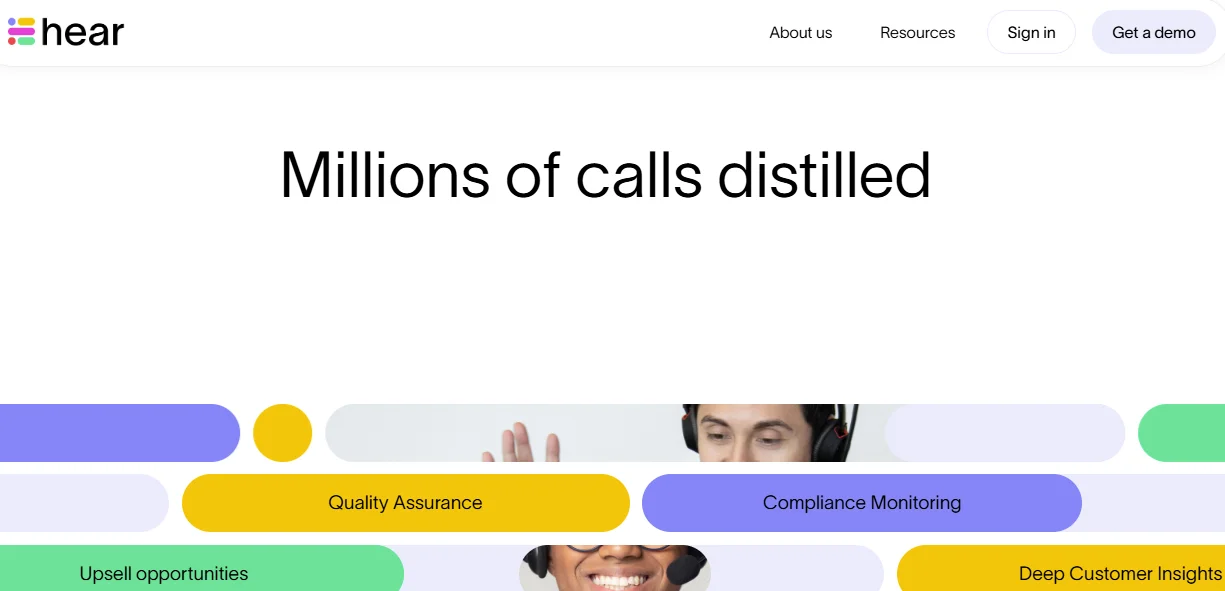Monitoring calls for quality assurance is a great way to ensure consistent service quality and high levels of customer satisfaction at a contact center.
However, quality assurance goes beyond just monitoring calls. You can also monitor interactions across other channels, such as email and chats.
With the right conversation intelligence tool, you can analyse 100% of customer interactions across various channels to get a well-rounded view of agent performance and customer satisfaction.
You can use Hear to improve your quality assurance monitoring process through automation, instant data-informed insights, and time savings.
For example, Hear automates QA scoring and compliance flagging, helps reduce handling time, and surfaces insights that benefit both customers and the business.
Ready to automate QA monitoring and other processes? Book a demo today.

What Is Quality Assurance?
In a contact center, quality assurance (QA) is the process customer experience team leaders use to monitor, measure, and improve the quality of agent-customer interactions and overall service delivery.
The process involves reviewing calls, emails, or chats to assess an agent's compliance with protocols, communication skills, product knowledge, and overall customer experience.
Difference Between Quality Assurance and Quality Control
While they are related and meant to maintain high service standards, quality assurance and quality control (QC) differ in several ways.
QA focuses on ensuring an agent's performance meets industry standards and a client's quality requirements. The practice is proactive in preventing errors by improving training and processes.
QA includes agent training, designing call scripts, improving process consistency, monitoring interactions for coaching, setting quality standards, and continuous improvement.
On the other hand, QC is a reactive, inspection-oriented approach that focuses on service quality by identifying and correcting errors after they occur.
You can use QC to see how your agents or processes deviate from set quality standards.
Your QC process should include reviewing completed interactions, call scoring, checking interactions for poor service or errors, identifying process or tone breaches, and handling escalation.

The Importance of Quality Assurance Monitoring
Quality assurance monitoring provides the following benefits:
- Improved Customer Experience: You can identify and address customer pain points to ensure consistent and positive interactions. The return will be higher customer satisfaction and loyalty.
- Better Agent Performance: Regular monitoring and feedback allow for targeted coaching, which empowers your agents to improve their skills and confidence. The agents will then be able to handle customer interactions better and enjoy increased job satisfaction.
- Consistent Service Quality: QA monitoring ensures all your agents adhere to the quality standards and procedures you've established, which helps ensure the level of service is fairly uniform across all interactions.
- Improved Regulatory Compliance: QA monitoring helps you ensure that all interactions comply with relevant company policies and regulations to avoid penalties.
- Informed Decision-Making: Through QA monitoring, you get valuable data-driven insights into agent performance, customer behavior, and operational efficiency. These help you make better informed decisions.

Types of QA Monitoring
You can use several types of contact center QA monitoring to achieve different results depending on the focus.
Some common types of QA monitoring include:
- Random Monitoring: You can use AI to analyze calls, chats, or emails at random to spot trends.
- Targeted Monitoring: With targeted monitoring, you review specific interactions based on criteria such as escalation, high-value customers, or long call durations. This option investigates known issues or high-risk areas further to help you improve processes.
- Scorecard-Based Monitoring: You can use a premade scorecard to evaluate agent performance across areas such as tone, accuracy, script adherence, and compliance. The practice ensures you get consistent, fair, and measurable reviews that lead to better performance tracking, coaching, and reporting.
- Speech Analytics: Automated call center quality assurance can help you analyze all customer interactions for certain keywords, sentiment, and compliance. AI enables you to monitor at scale and detect patterns to experience the benefits of speech analytics, such as increased compliance, improved agent performance, and better customer experience.
- Side-by-Side Monitoring: As a customer experience leader, you can listen live or sit with your agents through interactions. You get the opportunity to provide instant feedback and coaching, which works well for new hires and agents who need to improve.
- Silent Monitoring: You can do quality assurance call monitoring by listening to calls live, but without the agent or customer knowing. The idea is to observe natural customer and agent behavior without influence.
- Recorded Monitoring: This is a post-interaction approach where you review recorded calls and play them back to evaluate the interaction more closely. You get a thorough, analytical view of interactions over time, helping you identify long-term trends and ongoing coaching needs.
- Customer Feedback Monitoring: You can ask customers to share feedback after interactions to align quality assurance with actual customer experience. This tactic can help you close the gap between your internal perception of QA and how customers perceive it externally.

Quality Assurance Monitoring Tools
Monitoring quality assurance manually is overwhelming. The good news is that modern tools can automate the process, especially through artificial intelligence. You can explore these top QA monitoring tools.
1. Hear

Hear is a robust AI-driven conversation intelligence platform for contact centers, which can help you with quality assurance monitoring through:
- Automating Quality Assurance: Hear automatically scores and reviews 100% of your customer interactions, rather than random samples, using consistent and customizable criteria. With this comprehensive cross-channel approach, you can ensure consistent service quality, performance tracking, and coaching recommendations.
- Tailored Coaching with Data-Driven Insights: You can improve agent performance through objective feedback and coaching based on insights from real agent and customer behavior. Hear supports objective and personalized evaluations when you analyze all interactions instead of using the subjective sampling approach.
- Tracking KPIs and Surfacing CX Issues: Hear's dynamic dashboards let you monitor critical agent metrics or Key Performance Indicators. You can spot customer experience issues that may cause friction and address them proactively.
- Faster, Smarter Decision-Making: Hear automatically detects trends and surfaces instant insights to show what is working and what is not without sifting through tedious manual processes. For example, Hear helped Shift make critical decisions that enabled it to achieve 30% fewer compliance violations, 25% faster issue resolution, and 20% improvement in agent performance.
- Efficient QA Processes and Methodologies: Through AI-powered automation, Hear reduces the effort and time you spend on manual activities like call reviews. You can refocus the time and energy you save on agent coaching, high-value business strategy, and emergent problems.
Transform QA monitoring into an efficient business function today — try Hear now.
2. Enthu.ai
As a QA tool, Enthu.ai offers sales performance insights and basic compliance tracking for small and mid-sized contact center teams.
3. Scorebuddy
You can use Scorebuddy if you prioritize simple, automated QA processes with both agent-facing tools and leadership-facing tools, such as QA scorecards.
4. Talkdesk
Talkdesk is a customer experience platform ideal for contact centers looking for basic compliance tracking, workforce management, and QA automation for enterprise-level environments.
Metrics and KPIs Used in QA Monitoring
To improve call center quality assurance, you must prioritize key performance indicators (KPIs) to measure and improve agent performance and overall customer satisfaction.
Here are some common QA metrics you can track to assess how effective, efficient, and customer-centric your operations are.
- First Call Resolution (FCR): This metric measures the percentage of customer issues an agent resolves during the first interaction. A high FCR shows efficient problem-solving, reduces the need for repeat calls, minimizes operational costs, and improves customer experience.
- Average Handling Time (AHT): You can use this metric to see the average time an agent takes to handle a customer interaction, including the talk time, hold time, and after-interaction work. A lower AHT can mean greater efficiency, but this must balance with effective problem resolution.
- Customer Satisfaction (CSAT): This score measures how your customers are satisfied with their interactions with your contact center. High CSAT scores mean positive customer experiences, strong agent performance, and overall contact center effectiveness.
When you use Hear, you can track and improve these metrics in one platform.
For example, Hear improves CSAT by monitoring emotion, tone, and the quality of resolution across calls.
Your FCR also improves because Hear gives you contextual feedback and instant suggestions that you can share with your agents.

Best Practices to Implement in Quality Assurance Monitoring
Applying the right best practices in contact center quality assurance monitoring can ensure consistency, enhance agent performance, and improve customer satisfaction.
Let's check out some of the top best practices in quality assurance you can apply.
- Define Clear and Consistent Quality Standards: Create well-defined benchmarks for customer service protocols, regulatory compliance, and performance, including metrics like call handling times. Teach your agents these standards, including how you measure them.
- Combine Different QA Monitoring Methods: Blend various monitoring methods or types to achieve a comprehensive overview of agent performance and customer experience. For example, use silent monitoring, side-by-side monitoring, and recorded monitoring to spot immediate performance issues and capture long-term patterns.
- Use Quality Assurance Monitoring Software: Look for a contact center conversation intelligence platform that can analyze 100% of voice, email, and chat interactions, flag compliance issues, and automate quality assurance scoring. Ensure the platform offers alerts and insights to help you see agents who need training or coaching, or how you can improve your services in general.
- Build an Open Feedback Culture: Encourage open and honest communication between agents and their supervisors and other CX leaders. Let the agents assess themselves and each other to foster a collaborative environment. Your feedback should be constructive, specific, and tied directly to measurable outcomes. Celebrate agents who not only deliver top-notch services but also incorporate feedback accurately.

Frequently Asked Questions (FAQs)
Here are answers to common questions to wrap up today's guide.
What Are the Common Challenges in QA Monitoring?
You may encounter common QA monitoring challenges such as pushback from agents, agent burnout, biased insights due to limited interaction sampling, insufficient customer feedback, and a lack of training resources.
You can avoid various challenges with Hear. For example, the ability to analyze 100% of interactions across different channels eliminates the insight bias caused by random interaction sampling.
How Does QA Monitoring Differ Across Industries?
QA monitoring varies significantly across industries due to differences in product or service characteristics, operational contexts, and regulatory requirements.
Industries like manufacturing focus on the quality of physical products, while service industries like contact centers prioritize service quality in terms of customer interactions and agent performance.
Who Should Be Responsible for QA Monitoring in a Team?
Quality Assurance managers are typically responsible for overseeing QA monitoring. They establish processes, define quality standards, and lead the QA team, among other roles.
CX leaders help the managers fulfill their role through guidance and support by offering customer insights and collaboratively developing customer-centric solutions.
That being said, it takes collective effort to monitor QA, and all team members should contribute.
How Can Small Businesses Implement Effective QA Programs?
As a small business, you can implement an effective QA program through clear goals and standards, constructive feedback to agents, using modern and budget-friendly tools to automate processes, and fostering a customer-centric culture.
Conclusion
Effective contact center quality assurance monitoring can help you make smarter decisions faster, improve agent performance through data-driven coaching insights, and reduce business costs through time and financial savings.
The trouble is that conducting the process manually is overwhelming, which is why you need a modern tool to automate various activities.
For example, with Hear, you can automate QA activities such as scoring and call reviews. You can also monitor critical agent performance metrics to uncover issues that may jeopardize your overall customer experience.
Book a demo today to see how you can streamline quality assurance with Hear.


